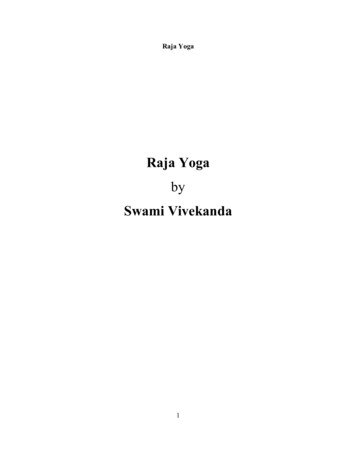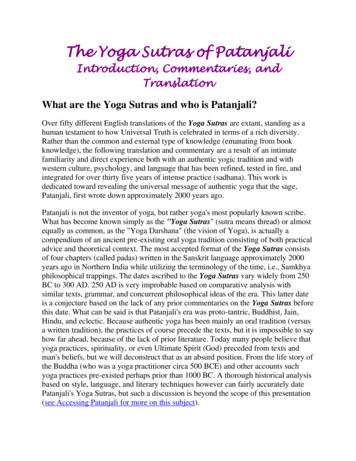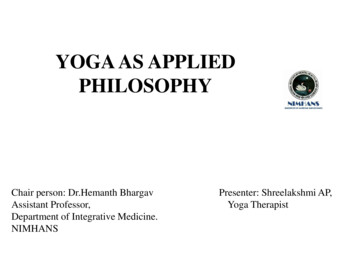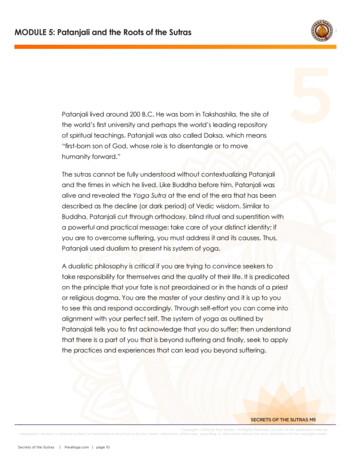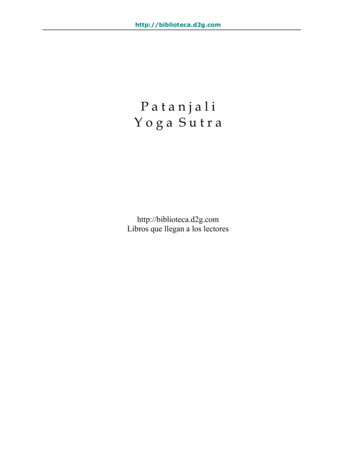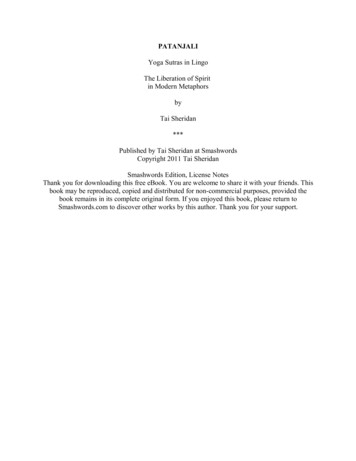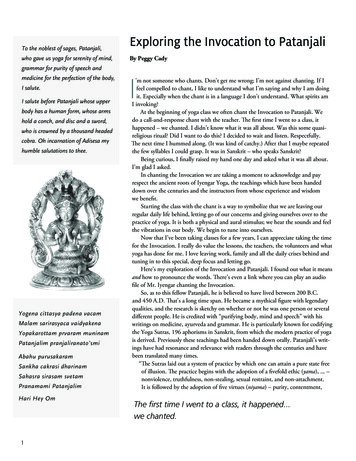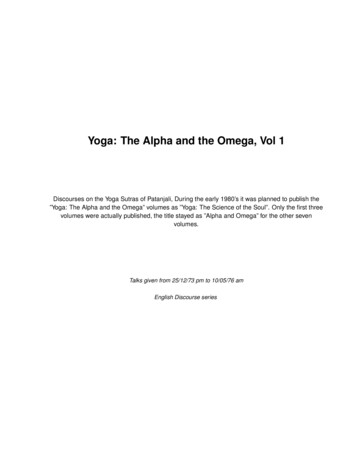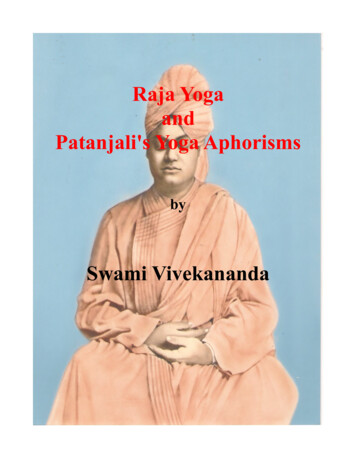
Transcription
Raja YogaandPatanjali's Yoga AphorismsbySwami Vivekananda
Raja YogaandPatanjali's Yoga AphorismsSwami VivekanandaPublisher: Swami Vivekananda QuotesEasy navigationTitle page, Contents, Book details, BackgroundBook 1 (Preface, Chapters I, II, III, IV, V, VI, VII, VIII) Book 2 (Introduction, Chapters I, II, III, IV, Appendix)
Easy navigationTitle page, Contents, Book details, BackgroundBook 1 (Preface, Chapters I, II, III, IV, V, VI, VII, VIII) Book 2 (Introduction, Chapters I, II, III, IV, Appendix)
Table of Contents1.2.Book detailsBackgroundBook 1Raja Yoga1.2.3.4.5.6.7.8.9.PrefaceIntroductoryThe First StepsPranaThe Psychic PranaThe Control Of The Psychic PranaPratyahara And DharanaDhyana And SamadhiRaja-Yoga In BriefBook 2Patanjali's Yoga Aphorisms1.2.3.4.5.6.IntroductionConcentration: Its Spiritual UsesConcentration: Its PracticePowersIndependenceAppendix - References To YogaEasy navigationTitle page, Contents, Book details, BackgroundBook 1 (Preface, Chapters I, II, III, IV, V, VI, VII, VIII) Book 2 (Introduction, Chapters I, II, III, IV, Appendix)
Book detailsPublisher: Swami Vivekananda QuotesDate: 28 February 2014Source: WikisourceLicense: Raja Yoga and Patanjali's Yoga Aphorisms written by Swami Vivekananda andpublished by Swami Vivekananda Quotes is licensed under a Creative Commons Attribution 4.0International License.Price: FreeEasy navigationTitle page, Contents, Book details, BackgroundBook 1 (Preface, Chapters I, II, III, IV, V, VI, VII, VIII) Book 2 (Introduction, Chapters I, II, III, IV, Appendix)
BackgroundSwami Vivekananda represented India at the Parliament of World's Religions in Chicago in 1893and there his historic lectures received overwhelming success and he himself found a lot ofattention from the people of United States. For next 4 years Vivekananda travelled extensively inAmerica and England and conducted hundreds of public and private lectures.Vivekananda's lectures on Raja Yoga were first published as a book in 1896. The book is dividedinto two parts (in this e-book, we'll call them “Book 1” and “Book 2”). The first part/bookcontains a preface section and Vivekananda's eight lectures on Raja Yoga, and the secondpart/book contains Patanjani's Yoga Aphorisms and Swami Vivekananda's commentaries andexplanations on those verses.Raja Yoga was one of Vivekananda's first books on the Yoga series (Karma Yoga was publishedin the same year). This book became very popular in America and attracted attention of manynotable Americans. Physiologist and psychologist William James was one of them. Later thebook influenced Russian writer Leo Tolstoy.Easy navigationTitle page, Contents, Book details, BackgroundBook 1 (Preface, Chapters I, II, III, IV, V, VI, VII, VIII) Book 2 (Introduction, Chapters I, II, III, IV, Appendix)
Book 1Raja YogaPrefaceSince the dawn of history, various extraordinary phenomena have been recorded as happeningamongst human beings. Witnesses are not wanting in modern times to attest to the fact of suchevents, even in societies living under the full blaze of modern science. The vast mass of suchevidence is unreliable, as coming from ignorant, superstitious, or fraudulent persons. In manyinstances the so - called miracles are imitations. But what do they imitate? It is not the sign of acandid and scientific mind to throw overboard anything without proper investigation. Surfacescientists, unable to explain the various extraordinary mental phenomena, strive to ignore theirvery existence. They are, therefore, more culpable than those who think that their prayers areanswered by a being, or beings, above the clouds, or than those who believe that their petitionswill make such beings change the course of the universe. The latter have the excuse of ignorance,or at least of a defective system of education, which has taught them dependence upon suchbeings, a dependence which has become a part of their degenerate nature. The former have nosuch excuse.For thousands of years such phenomena have been studied, investigated, and generalised, thewhole ground of the religious faculties of man has been analysed, and the practical result is thescience of Raja-Yoga. Raja-Yoga does not, after the unpardonable manner of some modernscientists, deny the existence of facts which are difficult to explain; on the other hand, it gentlyyet in no uncertain terms tells the superstitious that miracles, and answers to prayers, and powersof faith, though true as facts, are not rendered comprehensible through the superstitiousexplanation of attributing them to the agency of a being, or beings, above the clouds. It declaresthat each man is only a conduit for the infinite ocean of knowledge and power that lies behindmankind. It teaches that desires and wants are in man, that the power of supply is also in man;and that wherever and whenever a desire, a want, a prayer has been fulfilled, it was out of thisinfinite magazine that the supply came, and not from any supernatural being. The idea ofsupernatural beings may rouse to a certain extent the power of action in man, but it also bringsspiritual decay. It brings dependence; it brings fear; it brings superstition. It degenerates into ahorrible belief in the natural weakness of man. There is no supernatural, says the Yogi, but thereare in nature gross manifestations and subtle manifestations. The subtle are the causes, the grossthe effects. The gross can be easily perceived by the senses; not so the subtle. The practice ofRaja - yoga will lead to the acquisition of the more subtle perceptions.All the orthodox systems of India philosophy have one goal in view, the liberation of the soulthrough perfection. The method is by Yoga. The word Yoga covers an immense ground, but boththe Sankhya and the Vedanta Schools point to Yoga in some form or other.Easy navigationTitle page, Contents, Book details, BackgroundBook 1 (Preface, Chapters I, II, III, IV, V, VI, VII, VIII) Book 2 (Introduction, Chapters I, II, III, IV, Appendix)
The subject of the present book is that form of Yoga known as Raja-Yoga. The aphorisms ofPatanjali are the highest authority on Raja-Yoga, and form its textbook. The other philosophers,though occasionally differing from Patanjali in some philosophical points, have, as a rule,acceded to his method of practice a decided consent. The first part of this book comprises severallectures to classes delivered by the present writer in New York. The second part is a rather freetranslation of the aphorisms (Sutras) of Patanjali, with a running commentary. Effort has beenmade to avoid technicalities as far as possible, and to keep to the free and easy style ofconversation. In the first part some simple and specific directions are given for the student whowant to practise, but all such are especially and earnestly reminded that, with few exceptions,Yoga can only be safely learnt by direct contact with a teacher. If these conversations succeed inawakening a desire for further information on the subject, the teacher will not be wanting.The system of Patanjali is based upon the system of the Sankhyas, the points of difference beingvery few. The two most important differences are, first, that Patanjali admits a Personal God inthe form of a first teacher, while the only God the Sankhyas admit is a nearly perfected being,temporarily in charge of a cycle of creation. Second, the Yogis hold the mind to be equally all pervading with the soul, or Purusha, and the Sankhyas do not.—The Author.Each soul is potentially divine.The goal is to manifest this Divinity within by controlling nature, external and internal.Do this either by work, or worship, or psychic control, or philosophy — by one, or more, or allof these — and be free.This is the whole of religion. Doctrines, or dogmas, or rituals, or books, or temples, or forms, arebut secondary details.Easy navigationTitle page, Contents, Book details, BackgroundBook 1 (Preface, Chapters I, II, III, IV, V, VI, VII, VIII) Book 2 (Introduction, Chapters I, II, III, IV, Appendix)
Chapter IIntroductoryAll our knowledge is based upon experience. What we call inferential knowledge, in which wego from the less to the more general, or from the general to the particular, has experience as itsbasis. In what are called the exact sciences, people easily find the truth, because it appeals to theparticular experiences of every human being. The scientist does not tell you to believe inanything, but he has certain results which come from his own experiences, and reasoning onthem when he asks us to believe in his conclusions, he appeals to some universal experience ofhumanity. In every exact science there is a basis which is common to all humanity, so that we canat once see the truth or the fallacy of the conclusions drawn therefrom. Now, the question is: Hasreligion any such basis or not? I shall have to answer the question both in the affirmative and inthe negative.Religion, as it is generally taught all over the world, is said to be based upon faith and belief,and, in most cases, consists only of different sets of theories, and that is the reason why we findall religions quarrelling with one another. These theories, again, are based upon belief. One mansays there is a great Being sitting above the clouds and governing the whole universe, and heasks me to believe that solely on the authority of his assertion. In the same way, I may have myown ideas, which I am asking others to believe, and if they ask a reason, I cannot give them any.This is why religion and metaphysical philosophy have a bad name nowadays. Every educatedman seems to say, "Oh, these religions are only bundles of theories without any standard to judgethem by, each man preaching his own pet ideas." Nevertheless, there is a basis of universal beliefin religion, governing all the different theories and all the varying ideas of different sects indifferent countries. Going to their basis we find that they also are based upon universalexperiences.In the first place, if you analyse all the various religions of the world, you will find that these aredivided into two classes, those with a book and those without a book. Those with a book are thestrongest, and have the largest number of followers. Those without books have mostly died out,and the few new ones have very small following. Yet, in all of them we find one consensus ofopinion, that the truths they teach are the results of the experiences of particular persons. TheChristian asks you to believe in his religion, to believe in Christ and to believe in him as theincarnation of God, to believe in a God, in a soul, and in a better state of that soul. If I ask himfor reason, he says he believes in them. But if you go to the fountain-head of Christianity, youwill find that it is based upon experience. Christ said he saw God; the disciples said they feltGod; and so forth. Similarly, in Buddhism, it is Buddha's experience. He experienced certaintruths, saw them, came in contact with them, and preached them to the world. So with theHindus. In their books the writers, who are called Rishis, or sages, declare they experiencedcertain truths, and these they preach. Thus it is clear that all the religions of the world have beenbuilt upon that one universal and adamantine foundation of all our knowledge — directexperience. The teachers all saw God; they all saw their own souls, they saw their future, theysaw their eternity, and what they saw they preached. Only there is this difference that by most ofthese religions especially in modern times, a peculiar claim is made, namely, that theseexperiences are impossible at the present day; they were only possible with a few men, who wereEasy navigationTitle page, Contents, Book details, BackgroundBook 1 (Preface, Chapters I, II, III, IV, V, VI, VII, VIII) Book 2 (Introduction, Chapters I, II, III, IV, Appendix)
the first founders of the religions that subsequently bore their names. At the present time theseexperiences have become obsolete, and, therefore, we have now to take religion on belief. This Ientirely deny. If there has been one experience in this world in any particular branch ofknowledge, it absolutely follows that that experience has been possible millions of times before,and will be repeated eternally. Uniformity is the rigorous law of nature; what once happened canhappen always.The teachers of the science of Yoga, therefore, declare that religion is not only based upon theexperience of ancient times, but that no man can be religious until he has the same perceptionshimself. Yoga is the science which teaches us how to get these perceptions. It is not much use totalk about religion until one has felt it. Why is there so much disturbance, so much fighting andquarrelling in the name of God? There has been more bloodshed in the name of God than for anyother cause, because people never went to the fountain-head; they were content only to give amental assent to the customs of their forefathers, and wanted others to do the same. What righthas a man to say he has a soul if he does not feel it, or that there is a God if he does not see Him?If there is a God we must see Him, if there is a soul we must perceive it; otherwise it is better notto believe. It is better to be an outspoken atheist than a hypocrite. The modern idea, on the onehand, with the "learned" is that religion and metaphysics and all search after a Supreme Beingare futile; on the other hand, with the semi-educated, the idea seems to be that these things reallyhave no basis; their only value consists in the fact that they furnish strong motive powers fordoing good to the world. If men believe in a God, they may become good, and moral, and somake good citizens. We cannot blame them for holding such ideas, seeing that all the teachingthese men get is simply to believe in an eternal rigmarole of words, without any substancebehind them. They are asked to live upon words; can they do it? If they could, I should not havethe least regard for human nature. Man wants truth, wants to experience truth for himself; whenhe has grasped it, realised it, felt it within his heart of hearts, then alone, declare the Vedas,would all doubts vanish, all darkness be scattered, and all crookedness be made straight. "Yechildren of immortality, even those who live in the highest sphere, the way is found; there is away out of all this darkness, and that is by perceiving Him who is beyond all darkness; there isno other way."The science of Râja-Yoga proposes to put before humanity a practical and scientifically workedout method of reaching this truth. In the first place, every science must have its own method ofinvestigation. If you want to become an astronomer and sit down and cry "Astronomy!Astronomy!" it will never come to you. The same with chemistry. A certain method must befollowed. You must go to a laboratory, take different substances, mix them up, compound them,experiment with them, and out of that will come a knowledge of chemistry. If you want to be anastronomer, you must go to an observatory, take a telescope, study the stars and planets, and thenyou will become an astronomer. Each science must have its own methods. I could preach youthousands of sermons, but they would not make you religious, until you practiced the method.These are the truths of the sages of all countries, of all ages, of men pure and unselfish, who hadno motive but to do good to the world. They all declare that they have found some truth higherthan what the senses can bring to us, and they invite verification. They ask us to take up themethod and practice honestly, and then, if we do not find this higher truth, we will have the rightto say there is no truth in the claim, but before we have done that, we are not rational in denyingthe truth of their assertions. So we must work faithfully using the prescribed methods, and lightEasy navigationTitle page, Contents, Book details, BackgroundBook 1 (Preface, Chapters I, II, III, IV, V, VI, VII, VIII) Book 2 (Introduction, Chapters I, II, III, IV, Appendix)
will come.In acquiring knowledge we make use of generalisations, and generalisation is based uponobservation. We first observe facts, then generalise, and then draw conclusions or principles. Theknowledge of the mind, of the internal nature of man, of thought, can never be had until we havefirst the power of observing the facts that are going on within. It is comparatively easy to observefacts in the external world, for many instruments have been invented for the purpose, but in theinternal world we have no instrument to help us. Yet we know we must observe in order to havea real science. Without a proper analysis, any science will be hopeless — mere theorising. Andthat is why all the psychologists have been quarrelling among themselves since the beginning oftime, except those few who found out the means of observation.The science of Raja-Yoga, in the first place, proposes to give us such a means of observing theinternal states. The instrument is the mind itself. The power of attention, when properly guided,and directed towards the internal world, will analyse the mind, and illumine facts for us. Thepowers of the mind are like rays of light dissipated; when they are concentrated, they illumine.This is our only means of knowledge. Everyone is using it, both in the external and the internalworld; but, for the psychologist, the same minute observation has to be directed to the internalworld, which the scientific man directs to the external; and this requires a great deal of practice.From our childhood upwards we have been taught only to pay attention to things external, butnever to things internal; hence most of us have nearly lost the faculty of observing the internalmechanism. To turn the mind as it were, inside, stop it from going outside, and then toconcentrate all its powers, and throw them upon the mind itself, in order that it may know itsown nature, analyse itself, is very hard work. Yet that is the only way to anything which will be ascientific approach to the subject.What is the use of such knowledge? In the first place, knowledge itself is the highest reward ofknowledge, and secondly, there is also utility in it. It will take away all our misery. When byanalysing his own mind, man comes face to face, as it were, with something which is neverdestroyed, something which is, by its own nature, eternally pure and perfect, he will no more bemiserable, no more unhappy. All misery comes from fear, from unsatisfied desire. Man will findthat he never dies, and then he will have no more fear of death. When he knows that he is perfect,he will have no more vain desires, and both these causes being absent, there will be no moremisery — there will be perfect bliss, even while in this body.There is only one method by which to attain this knowledge, that which is called concentration.The chemist in his laboratory concentrates all the energies of his mind into one focus, and throwsthem upon the materials he is analysing, and so finds out their secrets. The astronomerconcentrates all the energies of his mind and projects them through his telescope upon the skies;and the stars, the sun, and the moon, give up their secrets to him. The more I can concentrate mythoughts on the matter on which I am talking to you, the more light I can throw upon you. Youare listening to me, and the more you concentrate your thoughts, the more clearly you will graspwhat I have to say.How has all the knowledge in the world been gained but by the concentration of the powers ofthe mind? The world is ready to give up its secrets if we only know how to knock, how to give itthe necessary blow. The strength and force of the blow come through concentration. There is nolimit to the power of the human mind. The more concentrated it is, the more power is brought tobear on one point; that is the secret.Easy navigationTitle page, Contents, Book details, BackgroundBook 1 (Preface, Chapters I, II, III, IV, V, VI, VII, VIII) Book 2 (Introduction, Chapters I, II, III, IV, Appendix)
It is easy to concentrate the mind on external things, the mind naturally goes outwards; but not soin the case of religion, or psychology, or metaphysics, where the subject and the object, are one.The object is internal, the mind itself is the object, and it is necessary to study the mind itself —mind studying mind. We know that there is the power of the mind called reflection. I am talkingto you. At the same time I am standing aside, as it were, a second person, and knowing andhearing what I am talking. You work and think at the same time, while a portion of your mindstands by and sees what you are thinking. The powers of the mind should be concentrated andturned back upon itself, and as the darkest places reveal their secrets before the penetrating raysof the sun, so will this concentrated mind penetrate its own innermost secrets. Thus will we cometo the basis of belief, the real genuine religion. We will perceive for ourselves whether we havesouls, whether life is of five minutes or of eternity, whether there is a God in the universe ormore. It will all be revealed to us. This is what Raja-Yoga proposes to teach. The goal of all itsteaching is how to concentrate the minds, then, how to discover the innermost recesses of ourown minds, then, how to generalise their contents and form our own conclusions from them. It,therefore, never asks the question what our religion is, whether we are Deists or Atheists,whether Christians, Jews, or Buddhists. We are human beings; that is sufficient. Every humanbeing has the right and the power to seek for religion. Every human being has the right to ask thereason, why, and to have his question answered by himself, if he only takes the trouble.So far, then, we see that in the study of this Raja-Yoga no faith or belief is necessary. Believenothing until you find it out for yourself; that is what it teaches us. Truth requires no prop tomake it stand. Do you mean to say that the facts of our awakened state require any dreams orimaginings to prove them? Certainly not. This study of Raja-Yoga takes a long time and constantpractice. A part of this practice is physical, but in the main it is mental. As we proceed we shallfind how intimately the mind is connected with the body. If we believe that the mind is simply afiner part of the body, and that mind acts upon the body, then it stands to reason that the bodymust react upon the mind. If the body is sick, the mind becomes sick also. If the body is healthy,the mind remains healthy and strong. When one is angry, the mind becomes disturbed. Similarlywhen the mind is disturbed, the body also becomes disturbed. With the majority of mankind themind is greatly under the control of the body, their mind being very little developed. The vastmass of humanity is very little removed from the animals. Not only so, but in many instances, thepower of control in them is little higher than that of the lower animals. We have very littlecommand of our minds. Therefore to bring that command about, to get that control over bodyand mind, we must take certain physical helps. When the body is sufficiently controlled, we canattempt the manipulation of the mind. By manipulating the mind, we shall be able to bring itunder our control, make it work as we like, and compel it to concentrate its powers as we desire.According to the Raja-Yogi, the external world is but the gross form of the internal, or subtle.The finer is always the cause, the grosser the effect. So the external world is the effect, theinternal the cause. In the same way external forces are simply the grosser parts, of which theinternal forces are the finer. The man who has discovered and learned how to manipulate theinternal forces will get the whole of nature under his control. The Yogi proposes to himself noless a task than to master the whole universe, to control the whole of nature. He wants to arrive atthe point where what we call "nature's laws" will have no influence over him, where he will beable to get beyond them all. He will be master of the whole of nature, internal and external. Theprogress and civilisation of the human race simply mean controlling this nature.Easy navigationTitle page, Contents, Book details, BackgroundBook 1 (Preface, Chapters I, II, III, IV, V, VI, VII, VIII) Book 2 (Introduction, Chapters I, II, III, IV, Appendix)
Different races take to different processes of controlling nature. Just as in the same society someindividuals want to control the external nature, and others the internal, so, among races, somewant to control the external nature, and others the internal. Some say that by controlling internalnature we control everything. Others that by controlling external nature we control everything.Carried to the extreme both are right, because in nature there is no such division as internal orexternal. These are fictitious limitations that never existed. The externalists and the internalistsare destined to meet at the same point, when both reach the extreme of their knowledge. Just as aphysicist, when he pushes his knowledge to its limits, finds it melting away into metaphysics, soa metaphysician will find that what he calls mind and matter are but apparent distinctions, thereality being One.The end and aim of all science is to find the unity, the One out of which the manifold is beingmanufactured, that One existing as many. Raja-Yoga proposes to start from the internal world, tostudy internal nature, and through that, control the whole — both internal and external. It is avery old attempt. India has been its special stronghold, but it was also attempted by other nations.In Western countries it was regarded as mysticism and people who wanted to practice it wereeither burned or killed as witches and sorcerers. In India, for various reasons, it fell into thehands of persons who destroyed ninety per cent of the knowledge, and tried to make a greatsecret of the remainder. In modern times many so-called teachers have arisen in the West worsethan those of India, because the latter knew something, while these modern exponents knownothing.Anything that is secret and mysterious in these systems of Yoga should be at once rejected. Thebest guide in life is strength. In religion, as in all other matters, discard everything that weakensyou, have nothing to do with it. Mystery-mongering weakens the human brain. It has well-nighdestroyed Yoga — one of the grandest of sciences. From the time it was discovered, more thanfour thousand years ago, Yoga was perfectly delineated, formulated, and preached in India. It is astriking fact that the more modern the commentator the greater the mistakes he makes, while themore ancient the writer the more rational he is. Most of the modern writers talk of all sorts ofmystery. Thus Yoga fell into the hands of a few persons who made it a secret, instead of lettingthe full blaze of daylight and reason fall upon it. They did so that they might have the powers tothemselves.In the first place, there is no mystery in what I teach. What little I know I will tell you. So far as Ican reason it out I will do so, but as to what I do not know I will simply tell you what the bookssay. It is wrong to believe blindly. You must exercise your own reason and judgment; you mustpractice, and see whether these things happen or not. Just as you would take up any otherscience, exactly in the same manner you should take up this science for study. There is neithermystery nor danger in it. So far as it is true, it ought to be preached in the public streets, in broaddaylight. Any attempt to mystify these things is productive of great danger.Before proceeding further, I will tell you a little of the Sânkhya philosophy, upon which thewhole of Raja-Yoga is based. According to the Sankhya philosophy, the genesis of perception isas follows: the affections of external objects are carried by the outer instruments to theirrespective brain centres or organs, the organs carry the affections to the mind, the mind to thedeterminative faculty, from this the Purusha (the soul) receives them, when perception results.Next he gives the order back, as it were, to the motor centres to do the needful. With theexception of the Purusha all of these are material, but the mind is much finer matter than theEasy navigationTitle page, Contents, Book details, BackgroundBook 1 (Preface, Chapters I, II, III, IV, V, VI, VII, VIII) Book 2 (Introduction, Chapters I, II, III, IV, Appendix)
external instruments. That material of which the mind is composed goes also to form the subtlematter called the Tanmâtras. These become gross and make the external matter. That is thepsychology of the Sankhya. So that between the intellect and the grosser matter outside there isonly a difference in degree. The Purusha is the only thing which is immaterial. The mind is aninstrument, as it were, in the hands of the soul, through which the soul catches external objects.The mind is constantly changing and vacillating, and can, when perfected, either attach itself toseveral organs, to one, or to none. For instance, if I hear the clock with great attention, I will not,perhaps, see anything although my eyes may be open, showing that the mind was not attached tothe seeing organ, while it was to the hearing organ. But the perfected mind can be attached to allthe organs simultaneously. It has the reflexive power of looking back into its own depths. Thisreflexive power is what the Yogi wants to attain; by concentrating the powers of the mind, andturning them inward, he seeks to know what is happening inside. There is in this no question ofmere belief; it is the analysis arrived at by certain philosophers. Modern physiologists tell us thatthe eyes are not the organ of vision, but that the organ is in one of the nerve centres of the brain,and so with all the senses; they also tell us that these centres are formed of the same material
contains a preface section and Vivekananda's eight lectures on Raja Yoga, and the second part/book contains Patanjani's Yoga Aphorisms and Swami Vivekananda's commentaries and explanations on those verses. Raja Yoga was one of Vivekananda's first books on the Yoga series (Karma Yoga was published in the same year).
